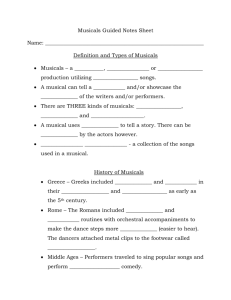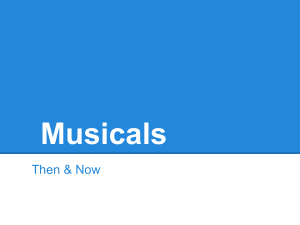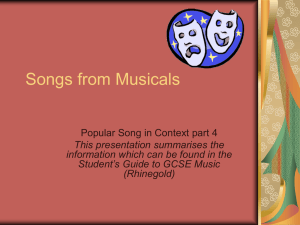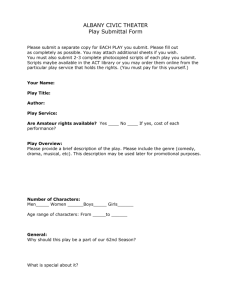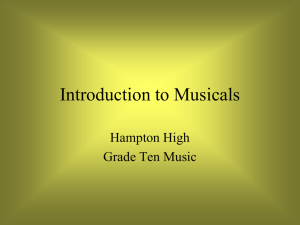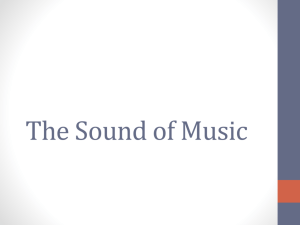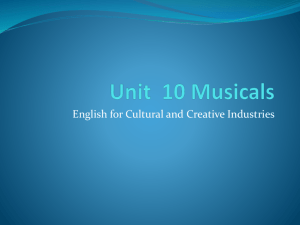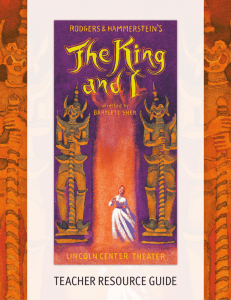File
advertisement
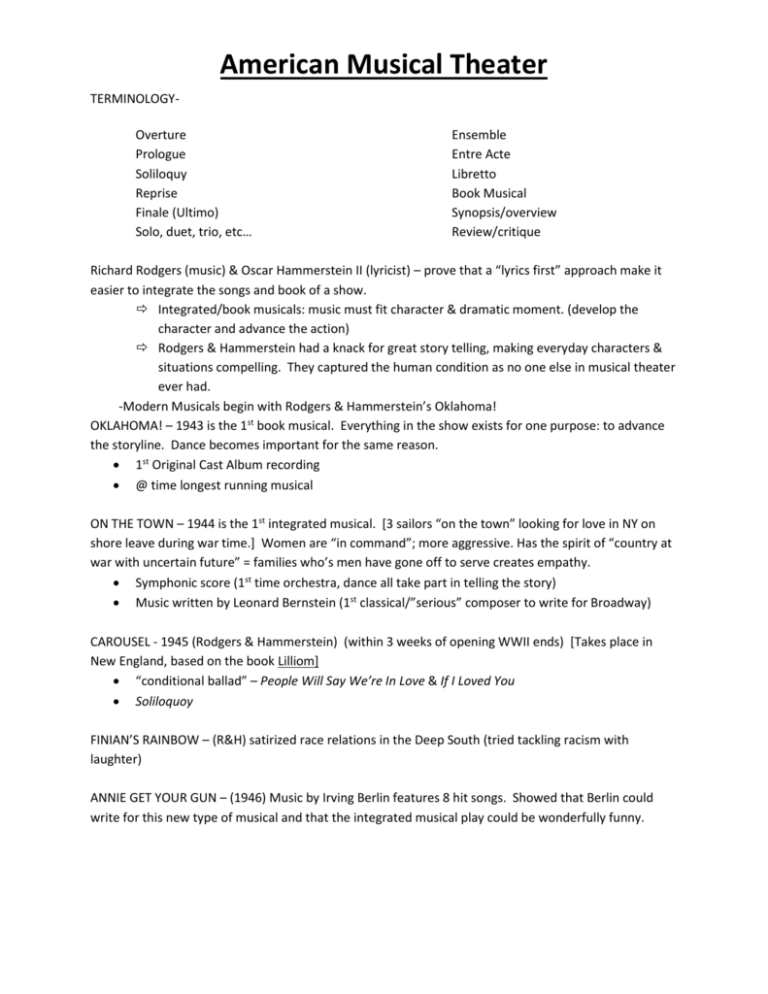
American Musical Theater TERMINOLOGYOverture Prologue Soliloquy Reprise Finale (Ultimo) Solo, duet, trio, etc… Ensemble Entre Acte Libretto Book Musical Synopsis/overview Review/critique Richard Rodgers (music) & Oscar Hammerstein II (lyricist) – prove that a “lyrics first” approach make it easier to integrate the songs and book of a show. Integrated/book musicals: music must fit character & dramatic moment. (develop the character and advance the action) Rodgers & Hammerstein had a knack for great story telling, making everyday characters & situations compelling. They captured the human condition as no one else in musical theater ever had. -Modern Musicals begin with Rodgers & Hammerstein’s Oklahoma! OKLAHOMA! – 1943 is the 1st book musical. Everything in the show exists for one purpose: to advance the storyline. Dance becomes important for the same reason. 1st Original Cast Album recording @ time longest running musical ON THE TOWN – 1944 is the 1st integrated musical. [3 sailors “on the town” looking for love in NY on shore leave during war time.] Women are “in command”; more aggressive. Has the spirit of “country at war with uncertain future” = families who’s men have gone off to serve creates empathy. Symphonic score (1st time orchestra, dance all take part in telling the story) Music written by Leonard Bernstein (1st classical/”serious” composer to write for Broadway) CAROUSEL - 1945 (Rodgers & Hammerstein) (within 3 weeks of opening WWII ends) [Takes place in New England, based on the book Lilliom] “conditional ballad” – People Will Say We’re In Love & If I Loved You Soliloquoy FINIAN’S RAINBOW – (R&H) satirized race relations in the Deep South (tried tackling racism with laughter) ANNIE GET YOUR GUN – (1946) Music by Irving Berlin features 8 hit songs. Showed that Berlin could write for this new type of musical and that the integrated musical play could be wonderfully funny. KISS ME KATE – 1948 (Cole Porter – music & lyrics) Taken from Shakespeare’s Taming of the Shrew Adult songs about love & sex – effected openness that we now have in music lyrics Received the 1st Tony Award for Best Musical SOUTH PACIFIC – (R&H) 1949 - looks at racial & cultural relationships (ie: war brides) You’ve Got To Be Carefully Taught [To Hate] “cashes in” on the still present emotional feelings about WWII “typical ‘decent’ Americans are forced to confront the bigotry they are raised with” Unusual show – almost no dance, more than 1 love story, dramatic tension not provided by a “bad guy” (both love stories are thwarted by the racial prejudices 2 American characters have been “carefully taught” since childhood. These reflex hatreds drive them to push away from the people they love Wins the Tony for Best Musical & becomes the 2nd musical to receive the Pulitzer Prize for Drama Their knack for creating innovative & entertaining hits is dubbed “The RH Factor” To this day, the shows of the 1950‘s form the core of the musical theater repertory. THE KING & I (1951-R&H), FLOWER DRUM SONG (1958-R&H), THE SOUND OF MUSIC (1959R&H) Oscar Hammerstein II dies a few months after THE SOUND OF MUSIC opened, ending a career that spaned the golden age of musical theater & film. Did his finest worl with Richard Rodgers & later coached Stephen Sondheim. His last song written was “Edelweiss.” Lyricist-librettist Alan Jay Lerner and composer Frederick Loewe followed ’47 hit BRIGADOON with PAINT YOUR SWAGON (1951) They surpass R&H at their own game with MY FAIR LADY (1956) based on George Bernard Shaw’s Pygmalion. Stars RexHarrison, Julie Andrews. Longest running musical up to that time. Wins every major award, revived several times translated all over the world. Return with CAMELOT (1960) Leonard Bernstein composed WEST SIDE STORY (1957) in collaboration with Sondheim. (inspired by Shakespeare’s Romeo & Juliet) GUYS & DOLLS – (1950-Frank Lesser) – characters are created “down to earth” & likeable THE MUSIC MAN (1957- Meredith Wilson writes book and lyrics) Sunset of the Golden age – 6 shows from ’64-’66 ran for over 1,000 performances: HELLO DOLLY! (1964),FUNNY GIRL (’64), FIDDLER ON THE ROOF (’64), MAN OF LA MANCHA (‘65), MAME (‘66), CABARET (‘66) 3 TYPES OF SHOWS IN THE ‘70’S (1) Rock musicals (2) concept shows (3) conventional post-Oklahoma musicals Rock Musicals – in the wake of HAIR, some folks thought that rock music was the one hope for Broadway musicals. 1st full-fledged rock opera JESUS CHRIST SUPERSTAR (1971-Andrew Lloyd Webber & librettist Tim Rice) -also- GODSPELL (1971-composer-librettist Stephen Schwartz) GREASE (1972), THE WIZ (1975) Company – (1970) [Concept Musical- built around a concept rather than a traditional plot-once a subject or situation is raised (marriage, love, etc) characters ca comment or illustrate on aspects of the subject. There is a story line, but it’s there to illustrate the central cocept ] songs provided commentary for characters but did not tell story as R&H musicals did. Moral: Life keeps going on; situations don’t end…” “what the audience came to a musical to avoid suddenly is staring them in the face.” No story line, non-linear story (flows back & forth in time) Late 70’s Deep recession. Theater district was filled with pornography, crime, etc… Dancers become important, reinvigorating Broadway (Dancer turned choreographer/writer: Michael Bennett). Worked on his own show in ’73 CHORUS LINE (recorded actions of dancers at workshop.) Kick line, shows bittersweet comments of the life of a dancer. Broke all existing records – 15 year run! Saved the Schubert Theater from financial ruin. 1973 – Bob Fosse wins 1st triple crown of theater. Wins Emmy, Tony (1972-Pippen) and Oscar(Cabaret) He offers a series of dance-centered musicals where the concept rather than traditional plot drove show. 1975 (& ’96 revival) CHICAGO – most enduring work (opened 5 days after Chorus Line) 1976 Stephen Sondheim & Hal Prince – PACIFIC OVERTURES (all male cast, set in 19th century Japan Kabuki style – Flops!) Late 70’s climate changing- most Americans not paying much attention to musical theater anymore. Rock & Disco predominant pop sounds, potential sales for cast albums had fallen so low that most major labels stopped recording them. Musicals become a small subculture. Worse still production costs getting out of hand, by ’79 most shows cost over 1 million a piece and operating costs were so high that they were not guaranteed to get a profit. 1979- SWEENEY TODD (Stephen Sondheim) tries to scare the modern audience. Play is about revenge. (1st to bring darkside of humanity on the stage). EVITA (’79-Webber & Rice) (Also teams up with Hal Prince for West Side Story) By end of ‘70’s Broadway becomes center piece for NY tourism campaign (“I Love NY” ad’s) 1980’s BRITISH MEGA-MUSICALS Producer David Merrick “The abominable showman” 40 yr career teamed up with director Gower Champion had 6 productions including HELLO DOLLY, 42ND STREET (1st movie musical adapted to stage). Merrick told critics to come to opening night instead of preview. Opening night of 42nd STREET the director died. Merrick announced it from the stage at the end of the performance (used it as a publicity stunt). CATS – 18 yr run [Longest running show in history!] produced by Cameron MacIntosh; Andrew Lloyd Webber , music – has almost no storyline but allows whole families (multiple generations to attend the theater and enjoy). “Memories” is a hit song (translated into dozens of languages). Merchandizing HUGE!! also produces 4 top musicals of the 80’s: PHANTOM, LES MISERABLES, MISS SAIGON – grosses $8 billion+ around the world. uses highly identifiable logos for advertising. INTO THE WOODS (’87-Sondheim) Wins Tony for best score MERRILY WE ROLL ALONG – last collaboration with Prince & Sondheim (flops) SUNDAY IN THE PARK WITH GEORGE – Sonheim w/o Prince. Gets inspiration from impressionistic painting. “Putting it Together” 1990’s – less than 5% of American public attending theater on any regular basis. CORPORATE MUSICALS take over – produced & managed by multi-functional entertainment corporations like Disney. BEAUTY & THE BEAST (1994-Disney) followed by THE LION KING (‘97) Versus off-Broadway shows like RENT (’96), BRING IN DA NOISE, BRING IN DA FUNK (’96), JEKYLL & HYDE (’97), TITANIC (’97), RAGTIME (’98) FILM ’96 Evita (featuring Madonna & Antonio Banderas), Beauty & the Beast (’91), Newsies (‘92) flops guaranteeing that Disney would stick to animation films, THE Lion King (’94), HUNCHBACK OF NOTRE DAME (’96), followed by shows that did less well HERCULES (‘97), MULAN (’98), TARZAN (’99) Beyond Disney the last Big screen musical of the 20th Century was SOUTH PARK: BIGGER, LONGER, UNCUT (’99)-proves that animated shows are not just for tots! MOULIN ROUGE (‘01), 8 MILE (‘02) starring Eminem, CHICAGO (’02) [Stage shows] Mel Brooks THE PRODUCERS (‘01) – scalps the scalpers! URINETOWN (’01,), MAMA MIA (‘01) (featuring music of ABBA, MOVIN OUT (‘02) featuring Billy Joel’s music, WICKED (‘03), AVENUE Q (‘03), ASSASSINS (‘04)

